Spatial Distribution of Nutrient Loads Based on Mineral Fertilizers Applied to Crops: Case Study of the Lobo Basin in Côte d’Ivoire (West Africa)
Abstract
:1. Introduction
2. Materials and Methods
2.1. Materials
2.1.1. Study Area
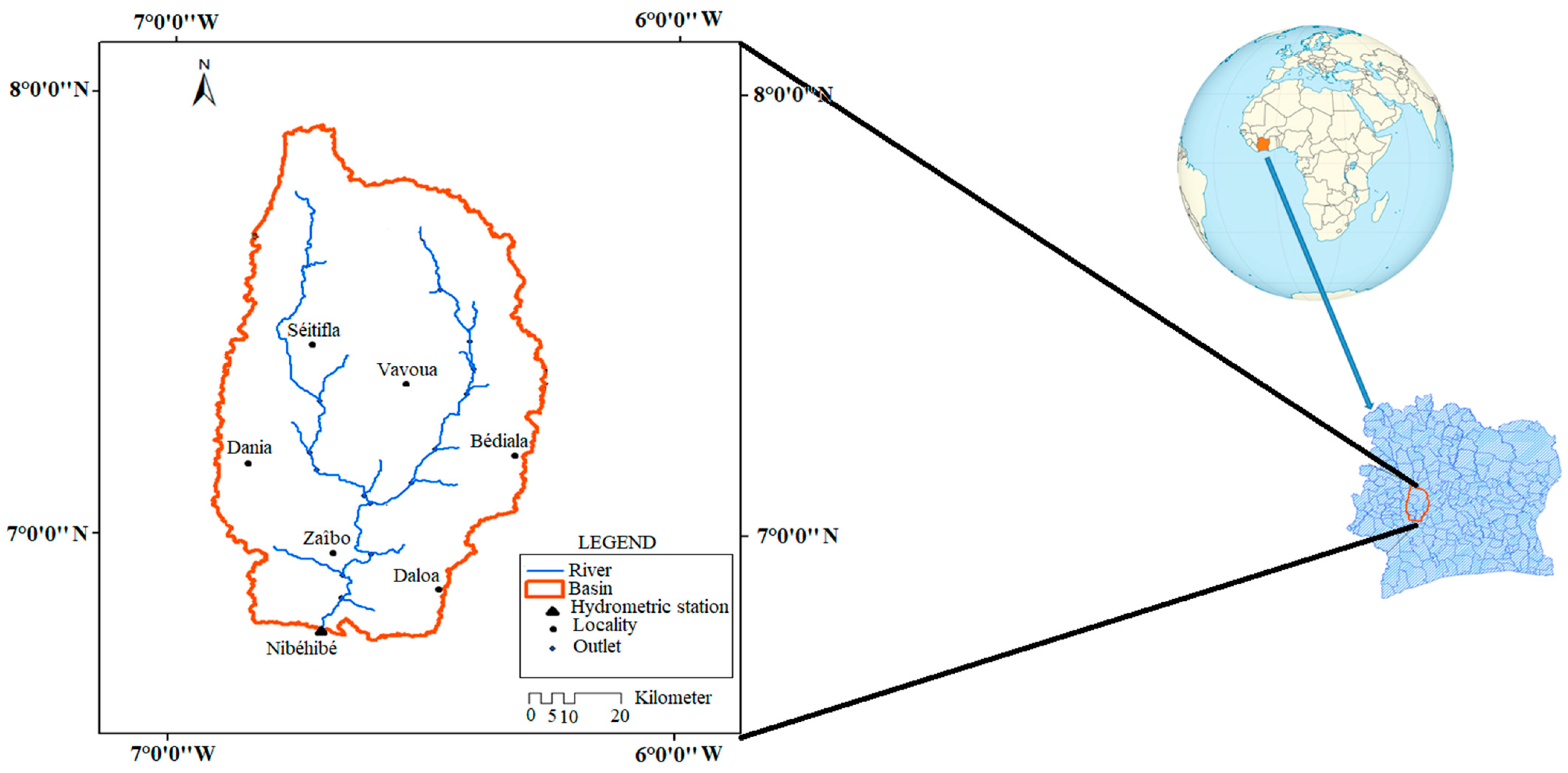
2.1.2. Data
Digital Elevation Model (DEM)
Land Use Map
Soil Data
Hydro-Climate Data
Agronomic Data
2.1.3. Computer Software
2.2. Methods
2.2.1. Flow Calibration
Model and Software Description
- SWAT Model description
- SWAT-CUP and SUFI-2 algorithm
- Global sensitivity analysis
- Uncertainty analysis
- Calibration analysis
- PBIAS < ±10: very good performance model;
- ±10 < PBIAS < ±15: good performance model;
- ±15 < PBIAS < ±25: satisfactory performance;
- PBIAS > ±25: unsatisfactory performance.
Model Setup
Streamflow Calibration Process
2.2.2. Nutrient Loads Estimation
3. Results
3.1. Streamflow Parameter Global Sensitivity
3.2. Streamflow Calibration and Uncertainty
3.3. Nutrients Fluxes
3.3.1. Nutrient Requirements for Crops
3.3.2. Mineral Nitrogen and Soluble Phosphorus Transferred per Sub-Basin
3.3.3. Organic Nitrogen and Organic Phosphorus Transferred per Sub-Basin
3.3.4. Nitrates and Soluble Phosphorus Concentrations in Streams
4. Discussion
5. Conclusions
Author Contributions
Funding
Institutional Review Board Statement
Informed Consent Statement
Data Availability Statement
Acknowledgments
Conflicts of Interest
References
- Economic Research Service, U.S. Department of Agriculture. Available online: https://www.ers.usda.gov/topics/international-markets-u-s-trade/u-s-agricultural-trade/ (accessed on 20 January 2023).
- REEA. Recensement des Exploitants et Exploitations Agricoles 2015/2016; Synthèse des Resultats du REEA. Rapport provisoire; Ministère de l’agriculture et du developpement rural: Abidjan, Cote d’Ivoire, 2017. [Google Scholar]
- RGPH. Recensement General de la Population et de l’Habitat 2021; Synthèse resultats globaux définitifs; Institut National de la Statistique: Abidjan, Cote d’Ivoire, 2022. [Google Scholar]
- Ferd, K. Contribution à L’étude de la Relation Entre L’utilisation Excessive des Engrais Agricoles et le Phénomène D’eutrophisation. Master’s Thesis, Université de Larbi Tébessi, Tébessa, Algeria, 2022. [Google Scholar]
- Eutrophisation: Manifestations, Causes, Conséquences et Prédictibilité. Available online: https://www.inrae.fr/sites/default/files/pdf/expertise-eutrophisation-resume-8-p-1.pdf (accessed on 14 August 2023).
- Lefebvre, A. Fleuves Français: Est-il Possible de Retrouver un bon état Ecologique? The Conversation. Available online: https://archimer.ifremer.fr/doc/00744/85602/90724.pdf (accessed on 3 August 2023).
- Ayele, H.S.; Atlabachew, M. Review of characterization, factors, impacts, and solutions of Lake eutrophication: Lesson for lake Tana, Ethiopia. Environ. Sci. Pollut. Res. 2021, 28, 14233–14252. [Google Scholar] [CrossRef] [PubMed]
- Poikane, S.; Kelly, M.G.; Várbíró, G.; Borics, G.; Erős, T.; Hellsten, S.; Kolada, A.; Lukács, B.A.; Solheim, A.L.; López, J.P.; et al. Estimating nutrient thresholds for eutrophication management: Novel insights from understudied lake types. Sci. Total Environ. 2022, 827, 154242. [Google Scholar] [CrossRef] [PubMed]
- Xu, W.; Duan, L.; Wen, X.; Li, H.; Li, D.; Zhang, Y.; Zhang, H. Effects of Seasonal Variation on Water Quality Parameters and Eutrophication in Lake Yangzong. Water 2022, 14, 2732. [Google Scholar] [CrossRef]
- Lin, S.-S.; Shen, S.-L.; Zhou, A.; Lyu, H.-M. Assessment and management of lake eutrophication: A case study in Lake Erhai, China. Sci. Total Environ. 2021, 751, 141618. [Google Scholar] [CrossRef]
- Van Oosterhout, F.; Yasseri, S.; Noyma, N.; Huszar, V.; Marinho, M.; Mucci, M.; Waajen, G.; Lürling, M. Assessing the long-term efficacy of internal loading management to controleutrophication in Lake Rauwbraken. Inland Waters 2022, 12, 61–77. [Google Scholar] [CrossRef]
- Suresh, K.; Tang, T.; Van Vliet, T.; Bierkens, F.; Stroka, A.; Sorger-Domenigg, F.; Wada, Y. Recent advancement in water quality indicators for eutrophication in global freshwater lakes. Environ. Res. Lett. 2023, 18, 063004. [Google Scholar] [CrossRef]
- Cheng, Y.; Zhang, H.; Yin, W. Nutrient transport following water transfer through the world’s largest water diversion channel. J. Environ. Sci. 2024, 135, 703–714. [Google Scholar] [CrossRef]
- Soro, M.-P.; N’goran, K.M.; Ouattara, A.A.; Yao, K.M.; Kouassi, N.L.; Diaco, T. Nitrogen and phosphorus spatio-temporal distribution and fluxes intensifying eutrophication in three tropical rivers of Côte d’Ivoire (West Africa). Mar. Pollut. Bull. 2023, 186, 114391. [Google Scholar] [CrossRef]
- N’goran, K.M.; Soro, M.-P.; Kouassi, N.L.B.; Trokourey, A.; Yao, K.M. Distribution, Speciation and Bioavailability of Nutrients in M’Badon Bay of Ebrie Lagoon, West Africa (Côte d’Ivoire). Chem. Afr. 2023, 6, 1619–1632. [Google Scholar] [CrossRef]
- Komelan, Y. Eutrophisation des Réservoirs D’eau en Côte d’Ivoire et Gestion de Leur Bassin Versant: Cas de Lobo à Daloa. Master’s Thesis, EIER, Ouagadougou, Burkina Faso, 1999. [Google Scholar]
- Maïga, A.; Denyigba, K.; Allorent, J. Eutrophisation des Petites Retenues d’eau en Afrique de l’Ouest: Causes et Conséquences: Cas de la Retenue D’eau de la Lobo en Côte d’Ivoire. Sud Sci. Technol. 2001, 7, 16–29. [Google Scholar]
- Die, K.K. Renforcement de L’alimentation en Eau Potable de La Ville de Daloa à Partir du Barrage de Buyo en Côte d’Ivoire. Master’s Thesis, EIER, Ouagadougou, Burkina Faso, 2006. [Google Scholar]
- Ohou-Yao, M.; Séka, A.; Mambo, V.; Yapo, O.; Konan, K.; Houénou, P. Contamination des eaux de puits traditionnels par les nitrates sur le bassin versant de la Lobo (Buyo, sud-ouest de la Côte d’Ivoire). J. Appl. Biosci. 2014, 78, 6654–6665. [Google Scholar] [CrossRef]
- Chocat, B. Amenagement urbain et hydrologie. La Houille Blanche 1997, 7, 12–19. [Google Scholar] [CrossRef]
- Refsgaard, J.C. Parameterization, calibration, and validation of distributed hydrological models. J. Hydrol. 1997, 198, 69–97. [Google Scholar] [CrossRef]
- Refsgaard, J.C.; Storm, B. Construction, calibration, and validation of hydrological models. In Distributed Hydrologic Modeling, 2nd ed.; Abbot, M.B., Refsgaard, J.C., Eds.; Kluwer Academic Publishers: Dordrecht, The Netherlands, 1996; pp. 41–54. [Google Scholar]
- Wischmeier, W.H.; Smith, D.D. Predicting Rainfall Erosion Losses. Agriculture Handbook 537; United States Department of Agriculture, Science and Education Administration: Washington, DC, USA, 1978; 58p. [Google Scholar]
- Perrin, C.; Michel, C.; Andréassian, V. Improvement of a parsimonious model for streamflow simulation. J. Hydrol. 2003, 279, 275–289. [Google Scholar] [CrossRef]
- Avenard, J.M. Aspect géomorphologique. In L’Environnement Naturel de Côte D’Ivoire, 2nd ed.; Avenard, J.M., Eldin, M., Girard, G., Sircoulon, J., Touchebeuf, P., Guillaumet, J.L., Adjanohoun, Perraud, A., Eds.; ORSTOM: Paris, France, 1971; pp. 11–72. [Google Scholar]
- Yao, A.B.; Goula, B.T.A.; Kouadio, Z.A.; Kouakou, K.E.; Kane, A.; Sambou, S. Analyse de la variabilité climatique et quantification des ressources en eau en zone tropicale humide: Cas du bassin versant de la Lobo au Centre-ouest de la Côte d’Ivoire. Rev. Ivoir. Sci. Technol. 2012, 19, 136–157. [Google Scholar]
- Jean Olivier, K.K.; Brou, D.; Jules, M.O.M.; Georges, E.S.; Frédéric, P.; Didier, G. Estimation of Groundwater Recharge in the Lobo Catchment (Central-Western Region of Côte d’Ivoire). Hydrology 2022, 9, 23. [Google Scholar] [CrossRef]
- Brou, Y.T. Climat, Mutations Socio-Économiques et Paysages en Côte d’Ivoire. Mémoire de Synthèse des Activités Scientifiques Présenté en vue de L’obtention de L’habilitation à Diriger des Recherches. Ph.D. Thesis, Université des Sciences et Techniques de Lille, Villeneuve-d’Ascq, France, 2005. [Google Scholar]
- Koua, T.J.-J.; Dhanesh, Y.; Jeong, J.; Srinivasan, R.; Anoh, K.A. Implementation of the Semi-Distributed SWAT (Soil and Water Assessment Tool) Model Capacity in the Lobo Watershed at Nibéhibé (Center-West of Côte D’Ivoire). J. Geosci. Environ. Prot. 2021, 9, 21–38. [Google Scholar] [CrossRef]
- Harmonized World Soil Database, Version 1.1. Available online: http://www.fao.org/fileadmin/templates/nr/documents/HWSD/HWSD_Documentation.pdf (accessed on 1 September 2012).
- Mbungu, W.B.; Kashaigili, J.J. Assessing the Hydroology of a Data-Scarce Tropical Watershed Using the Soil and Water Assessment Tool: Case of the Little Ruaha River Watershed in Iringa, Tanzania. Open J. Mod. Hydrol. 2017, 7, 65–89. [Google Scholar] [CrossRef]
- Arnold, J.G.; Srinivasan, R.; Muttiah, R.; Williams, J.R. Large area hydrologic modeling and assessment. Part I: Model development. J. Am. Water Res. Assoc. 1998, 34, 73–89. [Google Scholar] [CrossRef]
- Neitsch, S.L.; Arnold, J.G.; Kiniry, J.R.; Williams, R. Soil and Water Assessment Tool. Theoretical Documentation, Version 2005; Agricultural Research Service, Grassland, Soil and Water Research Laboratory: Temple, TX, USA, 2005. [Google Scholar]
- Refsgaard, J.C.; Van der Sluijs, J.P.; Højberg, A.L.; Vanrolleghem, P.A. Uncertainty in the Environmental Modelling Process—A framework and guidance. Environ. Model. Softw. 2007, 22, 1543–1556. [Google Scholar] [CrossRef]
- Schuol, J.; Abbaspour, K.C.; Srinivasan, R.; Yang, H. Modeling blue and green water availability in Africa. Water Resour. Res. 2008, 44, 1–18. [Google Scholar] [CrossRef]
- Bastin, L.; Cornford, D.; Jones, R.; Heuvlink, G.; Pebesma, E.; Stasch, C.; Nativi, S.; Mazzetti, P.; Williams, M. Managing uncertainty in integrated environmental modelling: The UncertWeb framework. Environ. Model. Softw. 2013, 39, 116–134. [Google Scholar] [CrossRef]
- Abbaspour, K.C.; Johnson, C.A.; Van Genuchten, M.T. Estimating uncertain flow and transport parameters using a sequential uncertainty fitting procedure. Vadose Zone J. 2004, 3, 1340–1352. [Google Scholar] [CrossRef]
- Abbaspour, K.C.; Yang, J.; Maximov, I.; Siber, R.; Bogner, K.; Mieleitner, J.; Zobrist, J.; Srinivasan, R. Modelling hydrology and water quality in the pre-alpine/alpine Thur watershed using SWAT. J. Hydrol. 2007, 333, 413–430. [Google Scholar] [CrossRef]
- Beven, K.; Binley, A. The future of distributed models—Model calibration and uncertainty prediction. Hydrol. Process. 1992, 6, 279–298. [Google Scholar] [CrossRef]
- Eberhart, R.C.; Kennedy, J. A new optimizer using particle swarm theory. In Proceedings of the Sixth International Symposium on Micro Machine and Human Science, Nagoya, Japan, 4–6 October 1995. [Google Scholar]
- Van Griensven, A.; Meixner, T. Methods to quantify and identify the sources of uncertainty for river basin water quality models. Water Sci. Technol. 2006, 53, 51–59. [Google Scholar] [CrossRef]
- Kuczera, G.; Parent, E. Monte Carlo assessment of parameter uncertainty in conceptual catchment models: The Metropolis algorithm. J. Hydrol. 1998, 211, 69–85. [Google Scholar] [CrossRef]
- Yang, J.; Reichert, P.; Abbaspour, K.C.; Xia, J.; Yang, H. Comparing uncertainty analysis techniques for a SWAT application to Chaohe Basin in China. J. Hydrol. 2008, 358, 1–23. [Google Scholar] [CrossRef]
- Abbaspour, K.C. SWAT Calibration and Uncertainty Programs—A User Manual; Swiss Federal Institute of Aquatic Science and Technology, EAWAG: Duebendorf, Switzerland, 2015. [Google Scholar]
- Gupta, H.V.; Sorooshian, S.; Yapo, P.O. Status of automatic calibration for hydrologic models: Comparison with multilevel expert calibration. J. Hydrol. Eng. 1999, 4, 135–143. [Google Scholar] [CrossRef]
- Coffey, M.E.; Workman, S.R.; Taraba, J.L.; Fogle, A.W. Statistical procedures for evaluating daily and monthly hydrologic model predictions. Trans. ASABE 2004, 47, 59–68. [Google Scholar] [CrossRef]
- Santhi, C.; Arnold, J.G.; Williams, J.R.; Dugas, W.A.; Srinivasan, R. Validation of the SWAT model on a large river basin with point and nonpoint sources. JAWRA 2001, 37, 1169–1188. [Google Scholar]
- Chu, T.W.; Shirmohammadi, A.; Montas, H.; Sadeghi, A. Evaluation of the SWAT model’s sediment and nutrient components in the piedmont physiographic region of Maryland. ASABE 2004, 47, 1523–1538. [Google Scholar] [CrossRef]
- Gassman, P.W.; Reyes, M.R.; Green, C.H.; Arnold, J.G. The soil and water assessment tool: Historical development, applications, and future research directions. Trans. ASABE 2007, 50, 1211–1250. [Google Scholar] [CrossRef]
- Moriasi, D.N.; Arnold, J.G.; Van Liew, M.W.; Bingner, R.L.; Harmel, R.D.; Veith, T.L. Model evaluation guidelines for systematic quantification of accuracy in watershed simulations. Trans. ASABE 2007, 50, 885–900. [Google Scholar] [CrossRef]
- Schuol, J.; Abbaspour, K.C.; Srinivasan, R.; Yang, H. Estimation of freshwater availability in the West African sub-continent using the SWAT hydrologic model. J. Hydrol. 2008, 352, 30–49. [Google Scholar] [CrossRef]
- Sintondji, L.O.; Awoye, H.R.; Agbossou, K.E. Modélisation du bilan hydrologique du bassin versant du Klou au Centre-Bénin: Contribution à la gestion durable des ressources en eau. Bull. La Rech. Agron. Du Bénin 2008, 59, 35–48. [Google Scholar]
- Rollo, N. Modélisation des Dynamiques de Pollution Diffuse dans Le Bassin Versant de la Rivière d’Auray: Quantification, Caractérisation et Gestion des Apports Nutritifs Terrigènes. Ph.D. Thesis, Université de Nantes, Nantes, France, 2012. [Google Scholar]
- Vilaysane, B.; Takara, K.; Luo, P.; Akkharath, I.; Duan, W. Hydrological stream flow modelling for calibration and uncertainty analysis using SWAT model in the Xedone river basin, Lao PDR. Procedia Environ. Sci. 2015, 28, 380–390. [Google Scholar]
- Aouissi, J.; Benabdallah, S.; Chabaâne, Z.; Cudennec, C. Evaluation of potential evapotranspiration assessment methods for hydrological modelling with SWAT-application in data-scarce rural Tunisia. Agric. Water Manag. 2016, 174, 39–51. [Google Scholar] [CrossRef]
- Havrylenko, S.B.; Bodoque, J.M.; Srinivasan, R.; Zucarelli, G.V.; Mercuri, P. Assessment of the soil water content in the Pampas region using SWAT. Catena 2016, 137, 298–309. [Google Scholar]
- Maliehe, M.; Mulungu, D.M. Assessment of water availability for competing uses using SWAT and WEAP in South Phuthiatsana catchment, Lesotho. Phys. Chem. Earth Parts A/B/C 2017, 100, 305–316. [Google Scholar] [CrossRef]
- Molina-Navarro, E.; Anderson, H.; Nielsen, A.; Thodsen, H.; Trolle, D. The impact of the objective function in multi-site and multi-variable calibration of the SWAT model. Environ. Model. Softw. 2017, 93, 255–267. [Google Scholar] [CrossRef]
- Tolson, B.A.; Shoemaker, C.A. Watershed Modeling of the Cannonsville Basin Using SWAT 2000, Model Development, Calibration and Validation for the Prediction of the Flow, Sediment and Phosphorus Transport to the Cannonsville Reservoir; Technical Report; School of Civil and Environmental Engineering, Cornell University: Ithaca, NY, USA, 2004. [Google Scholar]
- Koua, T.J.; Kouassi, K.H.; Anoh, K.A. Analysis of the SWAT (Soil and Water Assessment Tool) Semi-distributed Model Input Data for the Hydrological Simulation of the Lobo Water Reservoir (Central West of Côte d’Ivoire). J. Geogr. Environ. Earth Sci. Int. 2019, 23, 1–20. [Google Scholar] [CrossRef]
- Jenson, S.; Domingue, J. Extracting Topographic Structure from Digital Elevation Data for Geographic Information System Analysis. Photogramm. Eng. Remote Sens. 1998, 54, 1593–1600. [Google Scholar]
- Abbaspour, K.C. Swat-Cup2: SWAT Calibration and Uncertainty Programs Manual, 2nd ed.; Swiss Federal Institute of Aquatic Science and Technology, EAWAG: Duebendorf, Switzerland, 2011. [Google Scholar]
- McElroy, A.D.; Chu, S.Y.; Nebgen, J.W.; Aleti, A.; Bennett, F.W. Loading Functions for Assessment of Water Pollution from Nonpoint Sources; National Service Center for Environmental Publications (NSCEP): Cincinnati, OH, USA, 1976; pp. 76–151. [Google Scholar]
- Williams, J.R.; Hann, R.W. Optimal Operation of Large Agricultural Watersheds with Water Quality Constraints; Texas Water Resources Institute, Texas A & M Univ.: College Station, TX, USA, 1978. [Google Scholar]
- Menzel, R.G. Enrichment ratios for water quality modeling. In CREAMS: A Field Scale Model for Chemicals, Runoff, and Erosion from Agricultural Management Systems, 2nd ed.; Knisel, W.G., Ed.; U.S. Department of Agriculture: Washington, DC, USA, 1980; pp. 486–492. [Google Scholar]
- Alemayehu, T.; Gupta, H.V.; van Griensven, A.; Bauwens, W. On the Calibration of Spatially Distributed Hydrologic Models for Poorly Gauged Basins: Exploiting Information from Streamflow Signatures and Remote Sensing-Based Evapotranspiration Data. Water 2022, 14, 1252. [Google Scholar] [CrossRef]
- Anoh, K.; Koua, T.; Eblin, S.; Kouamé, K.; Jourda, J. Modelling Freshwater Availability Using SWAT Model at a Catchment-Scale in Ivory Coast. J. Geosci. Environ. Prot. 2017, 5, 70–83. [Google Scholar] [CrossRef]
- Dakhlalla, A.O.; Parajuli, B.P. Assessing model parameters sensitivity and uncertainty of streamflow, sediment, and nutrient transport using SWAT. Inf. Process. Agric. 2019, 6, 61–72. [Google Scholar] [CrossRef]
- Xu, H.; Taylor, R.G.; Kingston, D.G.; Jiang, T.; Thompson, J.R.; Todd, M.C. Hydrological modeling of River Xiangxi using SWAT2005: A comparison of model parameterizations using station and gridded meteorological observations. Quat. Int. 2010, 226, 54–59. [Google Scholar] [CrossRef]
- Strauch, M.; Bernhofer, C.; Koide, S.; Volk, M.; Lorz, C.; Makeschin, F. Using precipitation data ensemble for uncertainty analysis in SWAT streamflow simulation. J. Hydrol. 2012, 414–415, 413–424. [Google Scholar] [CrossRef]
- Vu, M.T.; Srinivasan, R.; Liong, S.Y. SWAT use of gridded observations for simulating runoff—A Vietnam river basin study. Hydrol. Earth Syst. Sci. 2012, 16, 2801–2811. [Google Scholar] [CrossRef]
- Tuo, Y.; Duan, Z.; Disse, M.; Chiogna, G. Evaluation of precipitation input for SWAT modeling in Alpine catchment: A case study in the Adige river basin (Italy). Sci. Total Environ. 2016, 573, 66–82. [Google Scholar] [CrossRef] [PubMed]
- Shen, Z.; Chen, L.; Liao, Q.; Liu, R.; Hong, Q. Impact of spatial rainfall variability on hydrology and nonpoint source pollution modeling. J. Hydrol. 2012, 472–473, 205–215. [Google Scholar] [CrossRef]
- Abbaspour, K.C.; Rouholahnejad, E.; Vaghefi, S.; Srinivasan, R.; Yang, H.; Kløve, B.A. Continental-scale hydrology and water quality model for Europe: Calibration and uncertainty of a high-resolution large-scale SWAT model. J. Hydrol. 2015, 524, 733–752. [Google Scholar] [CrossRef]
- Anoh, K.; Koua, T.; Kouamé, K.; Jourda, J.; Laurent, F. Modelling water flow in a complex watershed in humid a tropical area using SWAT: A case study of Taabo watershed in Ivory Coast. Int. J. River Basin Manag. 2018, 16, 157–167. [Google Scholar] [CrossRef]
- Etude Sur L’utilisation Des Engrais Par Produit Et Par Culture en Côte d’Ivoire. Available online: https://hub.ifdc.org/handle/20.500.14297/2271 (accessed on 20 April 2020).
- Bioteau, T.; Bordenave, P.; Laurent, F.; Ruelland, D. Evaluation des risques de pollution diffuse par l’azote d’origine agricole à l’échelle de bassins versants: Intérêts d’une approche par modélisation avec SWAT. Ingénieries-EAT 2002, 32, 3–13. [Google Scholar]
- Laurent, F.; Ruelland, D.; Chapdelaine, M. Simulation de l’effet de changements de pratiques agricoles sur la qualité des eaux avec le modèle SWAT. J. Water Sci. 2007, 20, 395–408. [Google Scholar] [CrossRef]
- Effet Combiné de NPK et de Trois Différents Mulchs D’origine végétale Sur la Production Maïsicole et la Fertilité Des Sols au Sud-Bénin. Available online: http://www.slire.net/download/2417/article_2_pg_brab_sp_cial_ta_sa_maliki_et_al_effet_combin_-npk.pdf. (accessed on 1 January 2022).
- Wetzel, R.G. Limnology: Lake and River Ecosystems, 3rd ed.; Academic Press: San Diego, CA, USA, 2001; 1006p. [Google Scholar]
- Koua, T. Apport de la Modélisation Hydrologique et des Systèmes d’Information Géographique (SIG) dans L’étude du Transfert Des Polluants et des Impacts Climatiques sur les Ressources en eau: Cas du bassin Versant du lac de Buyo (Sud-ouest de la Côte d’Ivoire). Ph.D. Thesis, Felix Houphouet Boigny University of Cocody, Abidjan, Côte d’Ivoire, 11 December 2014. [Google Scholar]
- Koukougnon, W.G. Milieu Urbain et Accès à l’eau Potable: Cas de Daloa (Centre-Ouestde la Cote d’Ivoire). Ph.D. Thesis, Felix Houphouet Boigny University of Cocody, Abidjan, Côte d’Ivoire, 2012. [Google Scholar]
- OECD—Organization for Economic Co-Operation and Development. Eutrophication of Waters. Monitoring, Assessment and Control; OECD: Paris, France, 1982; 154p. [Google Scholar]
- Dassi, C.; Mosi, L.; Narh, C.A.; Quaye, C. Distribution and Risk of Mycolactone-Producing Mycobacteria Transmission within Buruli Ulcer Endemic Communities in Côte d’Ivoire. Trop. Med. Infect. Dis. 2017, 2, 2–17. [Google Scholar] [CrossRef]
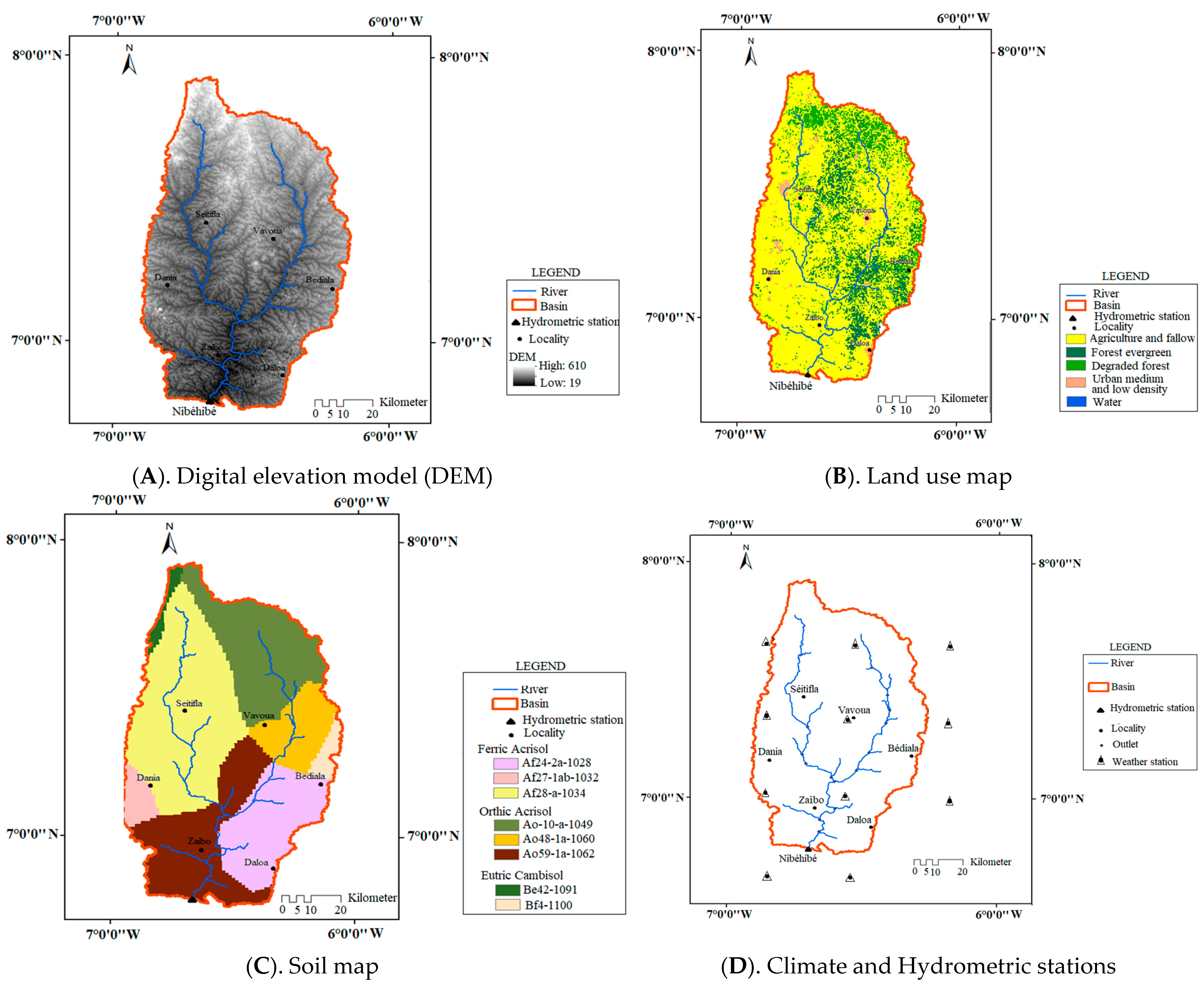
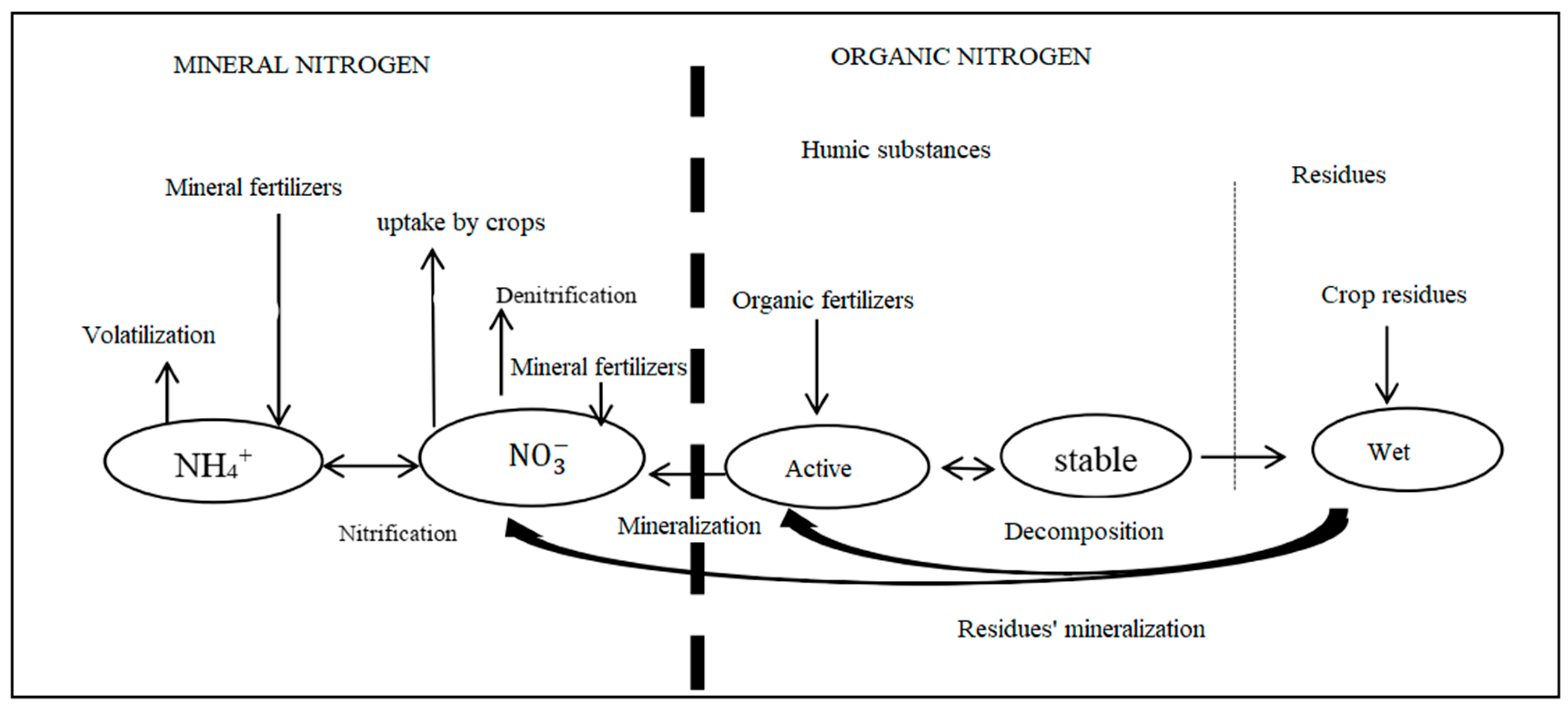


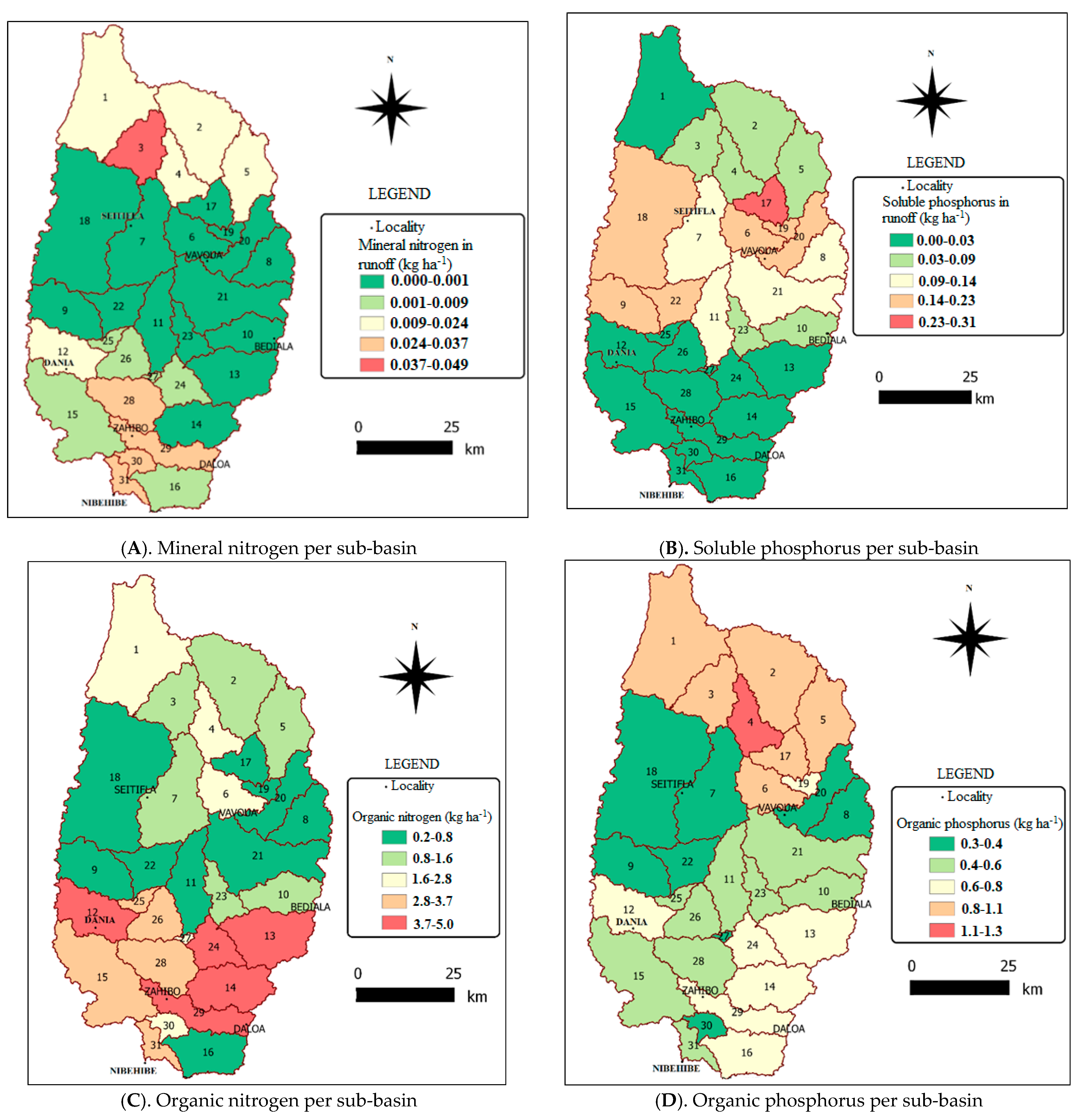
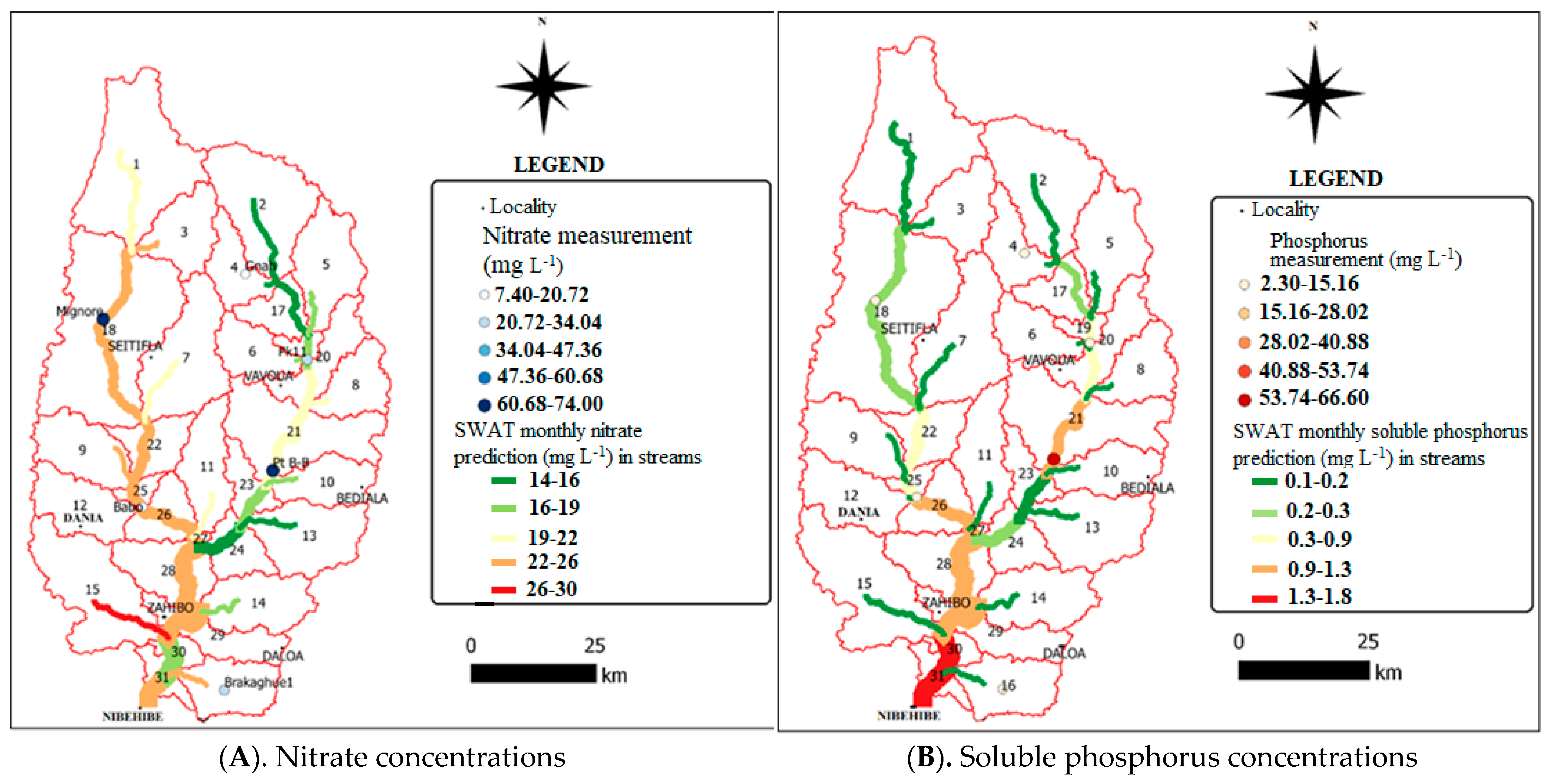
| Algorithm | Description |
|---|---|
| SUFI-2 | In SUFI 2, it is considered that the uncertainty in the simulations is observed in a uniform way. The sources of uncertainties are the driving variables, the conceptual model, parameters, and measured data. |
| GLUE | In this method, once the general probability has been defined, all the parameters are randomly sampled from the previous distribution. The parameters are thus grouped either into a behavioral set or into a non-behavioral set by comparing them to a given threshold probability. The parameters are then weighted according to their behavior. Finally, the uncertainty is predicted. |
| PSO | Here, the uncertainty prediction method is based on stochastic population optimization. The optimization is performed from a random sampling of parameters. |
| PARASOL | During the PARASOL method, a global optimization criterion (GOC) is first fixed. The method seeks to minimize the objective functions (OF) or GOC from the Shuffle Complex algorithm (SCE-UA). |
| MCMC | MCMC proceeds with a random sampling, which adapts to the posterior distribution. |
| Global Sensitivity Rank | Parameter | Parameter Description | Fitted Value | Minimum Value | Maximum Value |
|---|---|---|---|---|---|
| 1 | v__GW_REVAP | Groundwater revaporation coefficient | 0.1649 | 0.02 | 0.2 |
| 2 | a__GWQMN | Threshold depth of water in the shallow aquifer required for return flow to occur (mm) | −162 | −1000 | 1000 |
| 3 | a__RCHRG_DP | Deep aquifer percolation fraction | −0.0205 | −0.05 | 0.05 |
| 4 | v__ESCO | Soil evaporation compensation factor | 0.5465 | 0.5 | 0.8 |
| Global Sensitivity Rank | Parameter | Parameter Description | Fitted Value | Minimum Value | Maximum Value |
|---|---|---|---|---|---|
| 5 | r__CN2 | SCS runoff curve number function | 0.081 | −0.1 | 0.1 |
| 6 | a__GW_DELAY | Groundwater delay (days) | −28.83 | −30 | 60 |
| 7 | a__REVAPMN | Threshold depth of water in the shallow aquifer for “revap” to occur (mm) | 370.50 | −750 | 750 |
| 8 | v__ALPHA_BF | Baseflow alpha factor (days) | 0.945 | 0.00 | 1.00 |
| 9 | r__SOL_AWC | Available water capacity of the soil layer | −0.0143 | −0.05 | 0.05 |
| 10 | v__CANMX | Maximum canopy storage | 14.1749 | 0.00 | 15.00 |
| Statistic Coefficients | Value |
|---|---|
| R2 | 0.63 |
| NSE | 0.62 |
| PBIAS | −8.1 |
| P_factor | 0.48 |
| R_factor | 0.52 |
| Crop | Fertilizer (NPK) | Quantity (kg ha−1) | N Quantity (kg ha−1) | P Quantity (kg ha−1) |
|---|---|---|---|---|
| Cotton | 15-15-15 | 200 | 30 | 13.2 |
| Cocoa tree | 0-23-19 | 500 | 00 | 50.6 |
| Coffee | 12-06-20 | 784 | 94.08 | 79.34 |
| Cashew | 11-22-16 | 81.6 | 8.2 | 9.69 |
| Rice | 12-24-18 | 200 | 24 | 21.12 |
| Banana | 25-04-23 | 200 | 50 | 4.224 |
| Corn | 15-15-15 | 250 | 37.5 | 16.5 |
| Observed mean (CNRA) | 41 kg ha−1 | 28 kg ha−1 | ||
| SWAT | 47.24 kg ha−1 | 21.25 kg ha−1 | ||
Disclaimer/Publisher’s Note: The statements, opinions and data contained in all publications are solely those of the individual author(s) and contributor(s) and not of MDPI and/or the editor(s). MDPI and/or the editor(s) disclaim responsibility for any injury to people or property resulting from any ideas, methods, instructions or products referred to in the content. |
© 2023 by the authors. Licensee MDPI, Basel, Switzerland. This article is an open access article distributed under the terms and conditions of the Creative Commons Attribution (CC BY) license (https://creativecommons.org/licenses/by/4.0/).
Share and Cite
Koua, T.J.-J.; Jeong, J.; Alemayehu, T.A.; Dhanesh, Y.; Srinivasan, R. Spatial Distribution of Nutrient Loads Based on Mineral Fertilizers Applied to Crops: Case Study of the Lobo Basin in Côte d’Ivoire (West Africa). Appl. Sci. 2023, 13, 9437. https://doi.org/10.3390/app13169437
Koua TJ-J, Jeong J, Alemayehu TA, Dhanesh Y, Srinivasan R. Spatial Distribution of Nutrient Loads Based on Mineral Fertilizers Applied to Crops: Case Study of the Lobo Basin in Côte d’Ivoire (West Africa). Applied Sciences. 2023; 13(16):9437. https://doi.org/10.3390/app13169437
Chicago/Turabian StyleKoua, Tanoh Jean-Jacques, Jaehak Jeong, Tadesse Abitew Alemayehu, Yeganantham Dhanesh, and Raghavan Srinivasan. 2023. "Spatial Distribution of Nutrient Loads Based on Mineral Fertilizers Applied to Crops: Case Study of the Lobo Basin in Côte d’Ivoire (West Africa)" Applied Sciences 13, no. 16: 9437. https://doi.org/10.3390/app13169437
APA StyleKoua, T. J.-J., Jeong, J., Alemayehu, T. A., Dhanesh, Y., & Srinivasan, R. (2023). Spatial Distribution of Nutrient Loads Based on Mineral Fertilizers Applied to Crops: Case Study of the Lobo Basin in Côte d’Ivoire (West Africa). Applied Sciences, 13(16), 9437. https://doi.org/10.3390/app13169437








